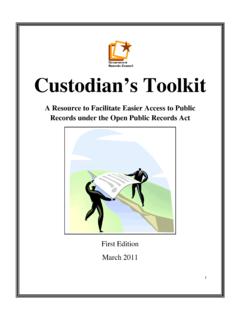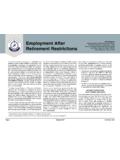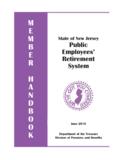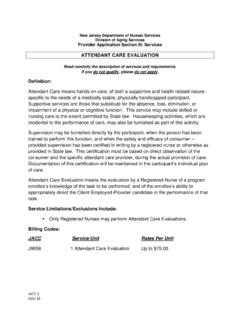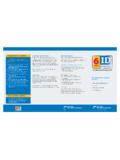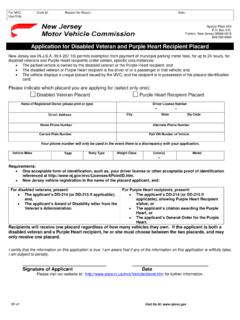Transcription of Right to Know Hazardous Substance Fact Sheet
1 Right to know Hazardous Substance fact Sheet Common Name: ETHYL ALCOHOL Synonyms: Alcohol; Methylcarbinol Chemical Name: Ethanol Date: March 2011 Revision: March 2016 CAS Number: 64-17-5 RTK Substance Number: 0844 DOT Number: UN 1170 Description and Use Ethyl Alcohol is a clear, colorless liquid with a wine-like odor. It is used in alcoholic beverages, as a solvent, and in making other chemicals. ODOR THRESHOLD = 84 ppm Odor thresholds vary greatly. Do not rely on odor alone to determine potentially Hazardous exposures. Reasons for Citation Ethyl Alcohol is on the Right to know Hazardous Substance List because it is cited by OSHA, ACGIH, DOT, NIOSH, IARC, NFPA and EPA. This chemical is on the Special Health Hazard Substance List. SEE GLOSSARY ON PAGE 5. FIRST AID Eye Contact Immediately flush with large amounts of water for at least 15 minutes, lifting upper and lower lids. Remove contact lenses, if worn, while rinsing.
2 Skin Contact Quickly remove contaminated clothing. Immediately wash contaminated skin with large amounts of soap and water. Inhalation Remove the person from exposure. Begin rescue breathing (using universal precautions) if breathing has stopped and CPR if heart action has stopped. Transfer promptly to a medical facility. EMERGENCY NUMBERS Poison Control: 1-800-222-1222 CHEMTREC: 1-800-424-9300 NJDEP Hotline: 1-877-927-6337 National Response Center: 1-800-424-8802 EMERGENCY RESPONDERS >>>> SEE LAST PAGE Hazard Summary Hazard Rating NJDHSS NFPA HEALTH - 2 FLAMMABILITY - 3 REACTIVITY - 0 FLAMMABLE POISONOUS GASES ARE PRODUCED IN FIRE CONTAINERS MAY EXPLODE IN FIRE Hazard Rating Key: 0=minimal; 1=slight; 2=moderate; 3=serious; 4=severe Ethyl Alcohol can affect you when inhaled and by passing through the skin. High concentrations may damage the fetus. Contact can irritate the skin and eyes. Prolonged or repeated exposure can cause drying and cracking of the skin with peeling, redness and itching.
3 Inhaling Ethyl Alcohol can irritate the nose, throat and lungs. Exposure to Ethyl Alcohol can cause headache, drowsiness, nausea and vomiting, and unconsciousness. It can also affect concentration and vision. Repeated high exposure may affect the liver and the nervous system. Ethyl Alcohol is a FLAMMABLE LIQUID and a DANGEROUS FIRE HAZARD. Workplace Exposure Limits OSHA: The legal airborne permissible exposure limit (PEL) is 1,000 ppm averaged over an 8-hour workshift. NIOSH: The recommended airborne exposure limit (REL) is 1,000 ppm averaged over a 10-hour workshift. ACGIH: The threshold limit value (TLV) is 1,000 ppm as a STEL (short-term exposure limit). The above exposure limits are for air levels only. When skin contact also occurs you may be overexposed, even though air levels are less than the limits listed above. ETHYL ALCOHOL Page 2 of 6 Determining Your Exposure Read the product manufacturer s Material Safety Data Sheet (MSDS) and the label to determine product ingredients and important safety and health information about the product mixture.
4 For each individual Hazardous ingredient, read the New Jersey Department of Health Hazardous Substance fact Sheet , available on the RTK website ( ) or in your facility s RTK Central File or Hazard Communication Standard file. You have a Right to this information under the New Jersey Worker and Community Right to know Act and the Public Employees Occupational Safety and Health (PEOSH) Act if you are a public worker in New Jersey, and under the federal Occupational Safety and Health Act (OSHA) if you are a private worker. The New Jersey Right to know Act requires most employers to label chemicals in the workplace and requires public employers to provide their employees with information concerning chemical hazards and controls. The federal OSHA Hazard Communication Standard (29 CFR ) and the PEOSH Hazard Communication Standard ( 12:100-7) require employers to provide similar information and training to their employees. This fact Sheet is a summary of available information regarding the health hazards that may result from exposure.
5 Duration of exposure, concentration of the Substance and other factors will affect your susceptibility to any of the potential effects described below. Health Hazard Information Acute Health Effects The following acute (short-term) health effects may occur immediately or shortly after exposure to Ethyl Alcohol: Contact can irritate the skin and eyes. Inhaling Ethyl Alcohol can irritate the nose, throat and lungs causing coughing and/or shortness of breath. Exposure to Ethyl Alcohol can cause headache, drowsiness, nausea and vomiting, and unconsciousness. It can also affect concentration and vision. Chronic Health Effects The following chronic (long-term) health effects can occur at some time after exposure to Ethyl Alcohol and can last for months or years: Cancer Hazard While Ethyl Alcohol has been tested, it is not classifiable as to its potential to cause cancer following occupational exposure. However, there is evidence that ingestion of Ethyl Alcohol (alcoholic beverages) may increase the risk of certain types of cancers (liver, esophagus, breast, prostate, and colorectal) in humans.
6 Reproductive Hazard Repeated exposure to Ethyl Alcohol (alcoholic beverages) may cause spontaneous abortions, as well as birth defects and other developmental problems. This condition is referred to as fetal alcohol syndrome. There is limited evidence that exposure to Ethyl Alcohol (alcoholic beverages) may decrease fertility in males. Other Effects Prolonged or repeated exposure can cause drying and cracking of the skin with peeling, redness and itching. Repeated high exposure may affect the liver and the nervous system. Medical Medical Testing For frequent or potentially high exposure (half the PEL or greater), the following are recommended before beginning work and at regular times after that: Liver function tests If symptoms develop or overexposure is suspected, the following is recommended: Analysis of blood, urine and exhaled breath for Ethyl Alcohol Any evaluation should include a careful history of past and present symptoms with an exam.
7 Medical tests that look for damage already done are not a substitute for controlling exposure. Request copies of your medical testing. You have a legal Right to this information under the OSHA Access to Employee Exposure and Medical Records Standard (29 CFR ). Mixed Exposures More than light alcohol consumption can cause liver damage. Drinking alcohol can increase the liver damage caused by Ethyl Alcohol. ETHYL ALCOHOL Page 3 of 6 Workplace Controls and Practices Very toxic chemicals, or those that are reproductive hazards or sensitizers, require expert advice on control measures if a less toxic chemical cannot be substituted. Control measures include: (1) enclosing chemical processes for severely irritating and corrosive chemicals, (2) using local exhaust ventilation for chemicals that may be harmful with a single exposure, and (3) using general ventilation to control exposures to skin and eye irritants. For further information on workplace controls, consult the NIOSH document on Control Banding at The following work practices are also recommended: Label process containers.
8 Provide employees with hazard information and training. Monitor airborne chemical concentrations . Use engineering controls if concentrations exceed recommended exposure levels. Provide eye wash fountains and emergency showers. Wash or shower if skin comes in contact with a Hazardous material. Always wash at the end of the workshift. Change into clean clothing if clothing becomes contaminated. Do not take contaminated clothing home. Get special training to wash contaminated clothing. Do not eat, smoke, or drink in areas where chemicals are being handled, processed or stored. Wash hands carefully before eating, smoking, drinking, applying cosmetics or using the toilet. In addition, the following may be useful or required: Before entering a confined space where Ethyl Alcohol may be present, check to make sure that an explosive concentration does not exist. Personal Protective Equipment The OSHA Personal Protective Equipment Standard (29 CFR ) requires employers to determine the appropriate personal protective equipment for each hazard and to train employees on how and when to use protective equipment.
9 The following recommendations are only guidelines and may not apply to every situation. Gloves and Clothing Avoid skin contact with Ethyl Alcohol. Wear personal protective equipment made from material which can not be permeated or degraded by this Substance . Safety equipment suppliers and manufacturers can provide recommendations on the most protective glove and clothing material for your operation. The recommended glove materials for Ethyl Alcohol are Butyl, Neoprene, Silver Shield /4H , Viton, Viton/Butyl and Barrier . The recommended protective clothing material for Ethyl Alcohol is Tychem CPF 3, or the equivalent. All protective clothing (suits, gloves, footwear, headgear) should be clean, available each day, and put on before work. Eye Protection Wear indirect-vent, impact and splash resistant goggles when working with liquids. If additional protection is needed for the entire face, use in combination with a face shield. A face shield should not be used without another type of eye protection.
10 Respiratory Protection Improper use of respirators is dangerous. Respirators should only be used if the employer has implemented a written program that takes into account workplace conditions, requirements for worker training, respirator fit testing, and medical exams, as described in the OSHA Respiratory Protection Standard (29 CFR ). Where the potential exists for exposure over 1,000 ppm, use a NIOSH approved supplied-air respirator with a full facepiece operated in a pressure-demand or other positive-pressure mode. For increased protection use in combination with an auxiliary self-contained breathing apparatus or an emergency escape air cylinder. Exposure to 3,300 ppm is immediately dangerous to life and health. If the possibility of exposure above 3,300 ppm exists, use a NIOSH approved self-contained breathing apparatus with a full facepiece operated in a pressure-demand or other positive-pressure mode equipped with an emergency escape air cylinder.
